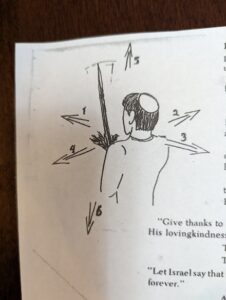Drash for Chayei Sarah
by Sandra Z. Armstrong
In the words of Rabbi Jonathan Sacks, It is God’s faith in us that keeps us going. Abraham brought God’s words to earth. We as the people of Israel are to follow these words knowing that God really does have faith in us even when we are “down and out” and not sure which way to turn. Faith is not certainty but the courage to live with uncertainty. God teaches us, inspires us, forgives us when we fall, but we must make this world. It is not what God does for us that transforms us. It is what we do for God.
Upon reading the Torah we find underlying patterns of comfort and hope. Patterns in nature parallel our patterns in life as human beings. I experienced these two sets of patterns unexpectedly.
I was on an airplane coming back from Denver airport to Honolulu during the winter. I glanced down through the plane’s window and discovered absolutely stunning patterns of snow as it settled across the tops of the mountains. Mazes and slopes of identical drifted snow in a constant flow of peaks. It was mesmerizing.
In Hawaiʻi, walking along the water’s edge during low tide, I saw the ocean slowly moving back and forth along the sand while glistening in the sunshine. To my surprise, I noticed identical patterns of diamonds caressing the sand. Back and forth in sweeping gestures as the water curved into brilliant sloping shapes across the sand.
Natural patterns occur on earth, yet we experience patterns in our lifetimes as human beings in relation to God. The parsha Chayei Sarah is a prime example of human patterning. Follow this scenario of human ingenuity when it comes to looking for guidance from God. The patterns are apparent among the directions, actions and answered prayers in this parsha:
It all begins with the mission to find a wife for Isaac.
Direction #1 into action along with prayer for success
(24:2) Abraham says to his servant: “Swear by the Lord the God of Heaven and the God of the earth that you will not take a wife from the daughter of the Canaanites” Furthermore Abraham answers when the servant inquires of how will I accomplish this task? And Abraham answers – 24:7 “God will send his angels before you”.
#2 (24:12)
Then prays the servant; “O’ Lord, God of my master Abraham, grant me good fortune this day, and deal graciously with my master”
#3 (24:13)
Again the servant prays to God, “Let the maiden to whom I say, please lower your jar that I may drink and replies “Drink and I will also water you camels. Please let her be the one decreed for your servant Isaac.
24:19 Rebekah is on the scene and uses exactly those words, “I will also draw for your camels”.
#4 (24:49) The servant recounts the whole pattern of prayer of God’s blessings before he sits down to eat with Laban & Bethuel. They state with specific input after the servant inquires …“Tell me also, that I may turn right or left.” They answer back: the matter was decreed by the Lord; we cannot speak to you bad or good.
#5 (24:67) Isaac is walking in the field which has been interpreted as praying and instituting the mincha service before evening when Rebekah and he make eye contact. They both know that they have met their intended. The pattern of praying and recognizing is almost complete until….
#6 (24:67) A final prayer completes the designed prayer with action when Isaac takes Rebecca into his mother’s tent. “Isaac loved her and thus found comfort after his mother’s death”.
I never quite understood until I studied this why the parsha was called The life of Sarah when it begins when she died.The very last line completes the pattern of prayers to God, action required and the positive result. Sarah lives on through the match of Isaac and Rebecca. Designated to be together through God’s protection, care and prayers.
The pattern continues when Sarah’s grandchild, Jacob, is eventually sent back to Laban with the promise from God in parsha Vayetzei. Jacob is assured by God that his descendants will be as the dust of the earth spread to the west, to the east, to the north and to the south. This is the same assurance from God given to his Grandfather Abraham who prayed in his lifetime whenever he needed help at pivotal points in his human mission. Abraham’s whole life paralleled patterns of praying and talking to God.
This six point pattern that appears in the story above reflects the six point pattern in the movement of our mitzvot during Sukkot to shake the lulav & etrog. This pattern equates directly to Chayei Sarah as God continues in all directions of our lives. What we pray for and what takes place between Heaven and Earth is evident in the Torah. Looking at the sheet that I handed out, I will show you what this mitzvah looks like of the six points of shaking the Lulav & Etrog into all directions of our lives, west, east, north and south (as paraphrased above and stated in the Torah). The six actions marked in the above prayer sequence add up when front up and then down are added for the mitzvah. You can see the pattern on the sheet that is diagrammed (and was passed around during the presentation). God is all around us in all that we do. As displayed in the action of shaking the Lulav & Etrog that represents the people of Israel as a whole, so too do we pattern our lives according to the reading of the Torah weekly.
(Picture of shaking the Lulav and Etrog attached below)
